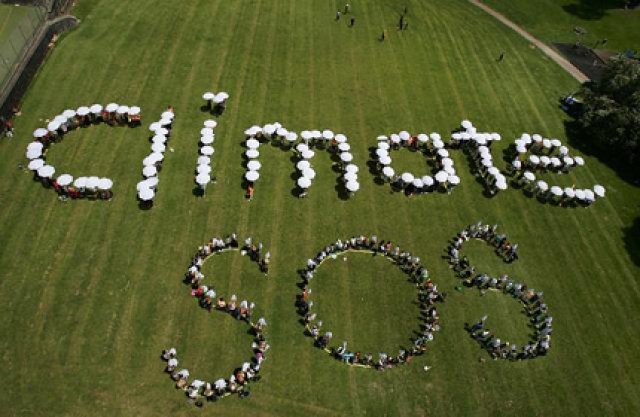
Dismayed by the Labor government’s inaction on climate change and looking for an alternative? Don’t look to the Liberals.
If the ALP has been dodgy on the issue, Tony Abbott’s party has been dodgier.
Sincere commitment on the issue is hard for Abbott. At a public meeting last September, he said global warming was “absolute crap”.
But the Liberal leader is remarkably consistent on one thing — the “need” to funnel large amounts of public money to big business.
Under the “direct action” emissions cuts program announced by the Liberals in February 2009, big carbon polluters would not pay for environmental damage they cause.
Instead, they would be bribed to pollute less. Or at least, relatively less.
When this $10 billion bribe runs out, Australian greenhouse emissions will not have been cut. Several studies have concluded the Liberals’ plans would see emissions grow by as much as 13% each year until 2020.
Labor’s weak (now postponed) Carbon Pollution Reduction Scheme would have put a price on carbon by forcing polluters to buy permits to cover their emissions. Total emissions would, in theory, be subject to a diminishing cap.
Under Abbott’s “direct action”, there will be no cap. Polluters could expand their operations, and pollute more, with no penalties — provided their emissions per unit of production do not rise.
If they reduce this “carbon intensity”, they will be rewarded $10-15 per tonne of carbon dioxide emissions “saved”.
Most estimates say this figure should be more than $20 a tonne. Consequently, the Liberals’ scheme would harvest only “low-hanging fruit” — that is, the cheapest emissions gains.
Abbott’s “direct action” might yield well in its first years, but its potential would quickly be exhausted.
On February 8, Andrew Macintosh of the ANU Centre for Climate Law and Policy said on Crikey.com that such incentive schemes “rarely work, are often rorted, generally result in higher abatement costs and aren’t equitable”.
In theory, the Liberal’s “direct action” would cut net emissions equal to Labor’s laughably inadequate target of 5% below 2000 levels by 2020.
The government would subsidise initiatives such as developing of coal-seam methane gas (a fossil fuel), waste emissions cuts, and improving energy efficiency.
Rebates would be provided for solar panels and solar hot water. Abbott also proposed incentives for the planting of 20 million trees.
The bulk of carbon abatement under his scheme— about 85 million tonnes of a total 140 million — would come from storing carbon in soils through improved farming practices.
There is nothing wrong with trees and soil carbon, but the Liberals need to do their arithmetic. The trees might credibly remove 20 million tonnes of carbon from the atmosphere over 10 years.
To have a major impact, the program needs to be far larger.
Meanwhile, trees burn in hot, dry conditions, which Australia will see plenty of in coming years. Heat and drought also reduce soil carbon, meaning it will get harder to make gains in that area.
A study released on February 4 by the federal Department of Climate Change disputed Abbott’s figures.
Using data from a similar program in NSW, the federal analysts concluded that the “direct action” measures would cut emissions by only 40 million tonnes by 2020, not the 140 million claimed.
Instead of falling by 5%, net emissions would rise by 13%, the study said.
A study by McKinsey management consultants and ClimateWorks found similar results.
The March 16 Sydney Morning Herald said the analysts concluded that only 27 million tonnes of carbon, not the Liberals’ 85 million, could be locked away in soils, “and only 18 million tonnes at the low price the Coalition has budgeted to pay”.
To help pay for its incentives, the federal opposition would cut other climate action programs.
Abbott said on July 20 he would dump the Global Carbon Capture and Storage Institute and save $300 million. The institute, set up by Rudd, was meant to unite world governments in pursuing “clean coal” technologies.
This leaves the Gillard Labor government as one of only a handful of big-league global peddlers of the “clean coal” delusion.
But Abbott would also cut useful programs. AAP said on July 20 that the Liberals would chop funding for renewable energy, for low-energy buildings, for greening small and medium business, and for aid to poorer countries to deal with climate change.
The Liberals are inconsistent on whether to put a price on carbon emissions. In a capitalist economy a clear, predictable carbon price — imposed, say, through a tax on fossil energy sources — could serve to deter firms from investing in polluting technologies.
Senior Liberal frontbencher Joe Hockey said in the May 20 Sydney Morning Herald, “Inevitably we’ll have a price on carbon … we’ll have to.”
But on July 18, Abbott told Sky News: “I do not support the government going out there and making consumers pay a price on carbon.”
Making it expensive for capitalists to pollute would not be enough. The challenge to cut Australia’s world-leading emissions rates is so large that massive, nationally coordinated state investment is essential. Private enterprise is not up to the job.
The energy industry would need to be re-nationalised — something neither major party is willing to consider.
For politicians loyal to big business, stopping climate change is just too hard. Labor keeps delaying action, while the Liberals prefer to dodge and obfuscate.
Liberal policy is better named “direct distraction”.
[Renfrey Clarke is the lead Senate candidate for the Socialist Alliance in South Australia.]